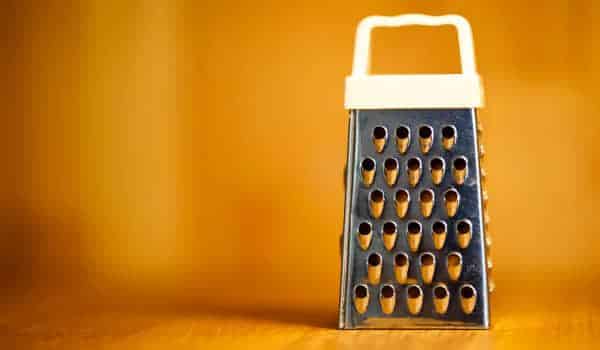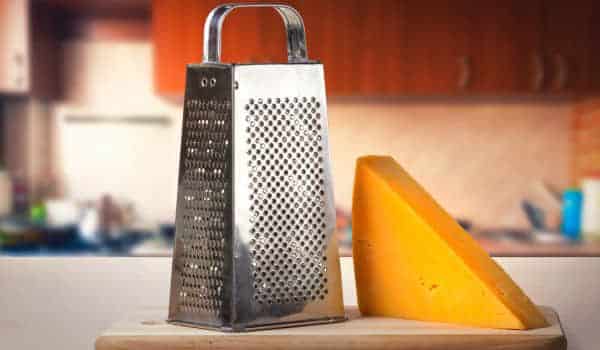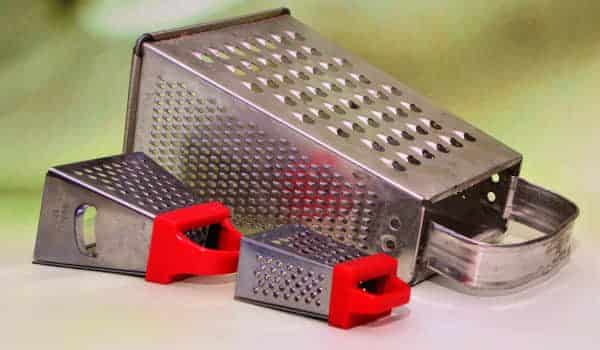Cleaning kitchen utensils is crucial to maintain hygiene and prevent cross-contamination. When it comes to cleaning a cheese grater, there are particular challenges due to the residual cheese particles that tend to stick in its sharp crevices. The tiny holes in the grater can trap cheese, making it difficult to clean thoroughly. Proper washing is essential not only to remove food remnants but also to prevent the transfer of flavors between different foods. Therefore, understanding effective cleaning methods for a cheese scraper is essential to ensure its hygiene and functionality.
How do I clean a cheese grater effectively?

To clean a cheese grater, start by rinsing it under hot water immediately after use to remove any cheese remnants. Use a dish brush or sponge to scrub both sides of the grater, paying extra attention to the grating surface. For stubborn cheese stuck in the grater’s holes, a small cleaning brush or toothbrush can be helpful.
Can I put a cheese grater in the dishwasher?

Most cheese graters are dishwasher-safe. However, it’s advisable to consult the manufacturer’s instructions to ensure your specific grater is dishwasher compatible. Placing it on the top rack of the dishwasher can prevent potential damage from intense heat or detergents.
Preparation for Cleaning

Safety measures: using gloves or handling carefully to avoid injury
Safety measures are crucial when preparing to clean a cheese grater. To ensure personal safety, it’s highly recommended to wear protective gloves or handle the scraper with extreme care due to its sharp edges and blades. Take extra caution while holding and cleaning the grater to prevent accidental cuts or injuries.
Removing excess cheese residue or food particles
Prior to diving into the cleaning process, it’s essential to tackle any excess cheese residue or food particles clinging to the grater. Begin by using a spatula or brush to remove larger pieces of leftover cheese. Running the grater under warm water can help dislodge and rinse away more stubborn particles.
Alternatively, soaking the grease in warm, soapy water for a few minutes can further loosen food remnants, making it easier to clean thoroughly. This initial step not only assists in clearing visible debris but also primes the scraper for more effective cleaning, ensuring a pristine finish.
Cleaning Methods

Handwashing
Handwashing stands as a primary and effective method for cleaning a cheese grater. Employ a dish brush or sponge to meticulously scrub the grater, focusing on both the surfaces and the small holes or blades where cheese particles tend to accumulate.
Utilize warm water and a sufficient amount of dish soap to ensure a thorough cleansing process, paying particular attention to these intricate parts to remove any trapped residue.
Soaking
Another viable approach for cleaning a cheese grater involves soaking it in warm, soapy water. Submerge the grater in the soapy water, allowing it to soak for a reasonable duration. This soaking action helps to loosen stubborn residues that might be difficult to remove through regular handwashing.
Post-soaking, gently scrub the scraper with a brush or sponge to dislodge and eliminate any remaining debris, ensuring a more comprehensive cleaning. This method proves effective in handling tougher residues and enhancing the overall cleanliness of the grater.
Utilizing a Brush or Toothbrush
An alternative and detailed approach to washing a cheese grater involves employing a small brush or even a toothbrush. These smaller tools enable focused cleaning, allowing you to reach tight spots or corners that might be challenging to access with larger washing utensils.
The use of a brush or toothbrush facilitates a more precise washing process, ensuring thorough removal of any lingering food particles or residue.
Dishwasher Use
If the cheese grater is dishwasher-safe, utilizing a dishwasher can be an efficient cleaning method. Before placing it in the dishwasher, ensure the grater’s material and construction are compatible with this cleaning method. Securely position the scraper in the dishwasher, taking care not to overcrowd the dishwasher to allow for proper washing.
Running it through a dishwasher cycle can effectively clean the scraper, providing a convenient and hands-free approach to maintaining its hygiene.
Drying and Storage

Air-drying the grater thoroughly to prevent rust or water stains
After cleaning, it’s crucial to ensure the cheese grater is thoroughly air-dried to prevent the formation of rust or water stains. Use a clean dish towel or allow it to air dry completely before storing.
Pay special attention to drying the scraper, especially in the small crevices and holes where water might accumulate, to maintain its quality and prevent any potential damage.
Storing in a clean, dry place
Store the completely dried cheese grater in a clean, dry place. Choose a location where it won’t be exposed to moisture or humidity, as this can lead to rust formation.
Storing it in a dry cabinet or drawer ensures its cleanliness and preserves the scraper for future use, ready for the next time it’s needed in your kitchen.
Tips for Maintenance

Immediate rinsing after use to prevent food from hardening
Rinsing the cheese grater immediately after use is a beneficial practice to prevent food remnants from hardening and sticking to the grater’s surface.
Running it under warm water or giving it a quick rinse helps prevent cheese or other foods from drying and becoming stubborn to remove, making the cleaning process more manageable.
Regular cleaning to avoid buildup
Regular cleaning of the cheese grater is essential to prevent the buildup of food residues. Even if not used frequently, giving it a quick rinse or cleaning after each use helps maintain its cleanliness.
This proactive approach prevents the accumulation of hardened food particles and ensures that the greater remains in good condition for longer periods.
Checking manufacturer’s instructions for specific cleaning guidelines
Consulting the manufacturer’s instructions or guidelines is advisable for specific cleaning and maintenance tips tailored to the particular type or material of the cheese scraper.
Manufacturers often provide guidance on the best cleaning practices that suit the grater’s construction, ensuring that you clean it effectively without causing any damage. Following these guidelines can contribute to prolonging the scraper’s lifespan and maintaining its performance.
Conclusion
Various effective cleaning methods for a cheese grater have been outlined, encompassing handwashing with a brush or sponge, soaking in warm, soapy water, using a small brush or toothbrush for detailed washing, and, if suitable, utilizing a dishwasher. These methods cater to different preferences and ensure thorough cleanliness.
The significance of maintaining clean kitchen utensils, particularly cheese graters, cannot be overstated. Ensuring their cleanliness not only safeguards against cross-contamination but also enhances the taste and quality of prepared dishes. Regular and diligent cleaning practices not only preserve the grater’s longevity but also contribute to a hygienic kitchen environment, promoting healthier meal preparation and overall well-being. Embracing and maintaining these practices foster a safer and more enjoyable cooking experience for everyone.
FAQ
How can I remove dried cheese stuck on the grater?
For dried or stubborn cheese residue, soaking the grater in warm, soapy water for a few minutes can help loosen the stuck-on cheese. After soaking, use a brush or sponge to scrub away the softened residue.
What should I do if there’s rust on my cheese grater?
Rust can be removed by gently scrubbing the affected area with a mixture of baking soda and water or using a non-abrasive rust remover. Afterward, thoroughly rinse and dry the grater to prevent further rusting.
Is it safe to use a metal brush or abrasive pads to clean a cheese grater?
While metal brushes or abrasive pads might effectively remove stubborn cheese, they can scratch or damage the grater’s surface. It’s advisable to use soft brushes, sponges, or non-abrasive cleaning tools to avoid harming the grater.
How can I ensure the cheese grater is completely dry after cleaning?
After washing, thoroughly dry the grater with a clean cloth or towel. To prevent moisture buildup, ensure all moisture is removed, especially from the inside of the grater’s holes, before storing it in a dry place.





